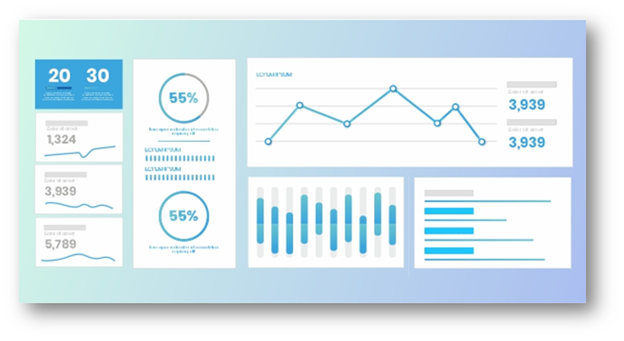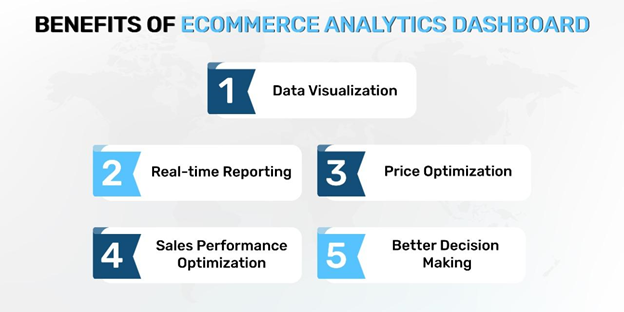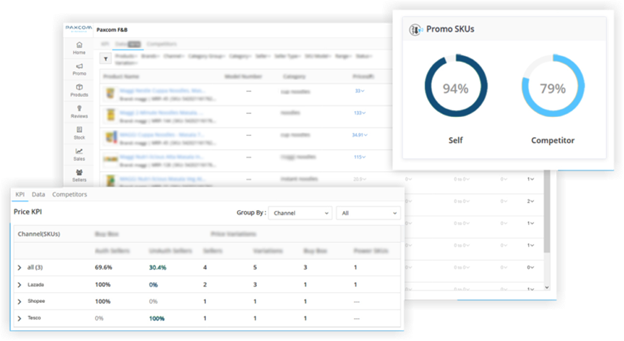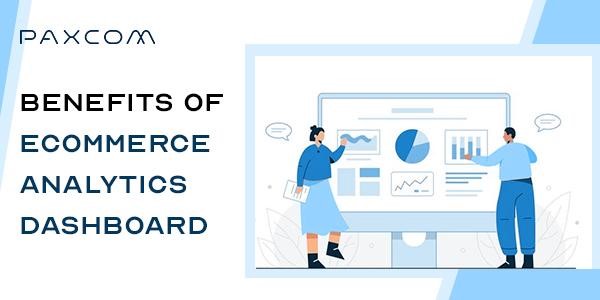Imagine having a tool that could help you understand your customer’s needs. Imagine being able to predict the market trends and hidden patterns, which could be a game-changer for your eCommerce business strategy. Imagine getting these advanced insights in one place.
In a world where companies use numerous different tools to track business performance, eCommerce analytics dashboards have become essential in helping you determine the best product mix, marketing strategies, and sales promotions to be used. Let’s first understand what an eCommerce analytics dashboard is.
Table of Contents
What is an eCommerce analytics dashboard?
An eCommerce dashboard provides you a clear overview of a selected set of KPIs, metrics, and other data designed to highlight trends, irregularities, and information related to an online store on a day-to-day basis. It provides centralized access to your team, allowing them to evaluate real-time information and make data-driven decisions.

What should you be tracking on your eCommerce analytics dashboard?
There is no one fixed answer to this. It depends on your business goals and the kind of data you need. For example, a beauty brand that sells its products worldwide would have a different set of metrics than a food store that serves a local community.
Furthermore, if you have a large business with various verticals, you might need several dashboards which cover everything from your eCommerce website performance to logistics to the performance of your marketing campaigns on multiple platforms.
Now there are tonnes of eCommerce metrics that are available for you to monitor. But not every metric is essential for the success of your business. Choosing the right metrics can be a confusing process if you’re new to the world of eCommerce. In this case, a prebuilt eCommerce analytics dashboard might be the right choice for you. Paxcom has this in house tool which provides –
1. Visibility
In order to reach your customers, your products first need to be visible and discoverable on relevant keyword search results (Share of Voice) and category pages. Our channel intelligence tool, Kinator, will help you improve your organic visibility by providing insights on the Share of Voice for relevant keywords & categories.
2. Pricing and Promotions
In the dynamic space of eCommerce, a brand must monitor the pricing of their products on online channels. Our channel intelligence Comparing pricing and promotions across the competition, platforms, sellers, and time periods, as well as tracking price violations by unauthorized sellers, will help you identify trends to improve your strategy.
3. Sentiment Analysis
Research shows that the majority of shoppers read between one and ten reviews before making a purchase decision. Kinator will help you track and analyze your negative reviews and ratings, maintain your online reputation, and achieve better customer satisfaction.
4. SKU availability
The availability of SKUs is crucial in this competitive space of eCommerce, where many e-commerce platforms deactivate or delist products that repeatedly go out of stock. This impacts sales and customer retention power. With Kinator, you can track stock status across all platforms and receive customized reports to avoid sales loss.
Why should you start using an eCommerce analytics dashboard?
How can you stay on top of trends if you have no data about what’s trending? Ecommerce analytics dashboards help you monitor pricing and promotions, analyze product visibility, identify gaps in supply chain efficiency, and decrease unnecessary expenditures on your campaigns. It gives you a birds-eye view of all the key performance indicators needed in your business.
There are numerous benefits to having an eCommerce analytics dashboard, including:

1. Data Visualization
When it comes to eCommerce strategies, storing large amounts of data for analysis is essential for maximizing profits and growth. But all the data and insights won’t be of any use if it isn’t presented in a way you can understand. Data visualization helps you and your team organize a large amount of data into actionable insights.
Ecommerce Analytics Dashboards can help turn these complex data chunks into easy-to-read graphs, pie charts, trend tracking, and tables. This data can also be presented in logical groupings for easy readability. You need to first understand your target audience and what questions they need answers to. For example, are they looking for sales data to change their promotional strategy? Or are they looking to see their performance in campaigns?
To grow your eCommerce business, you need to understand how every aspect of it works. We now work with huge amounts of collected data and need a good visualization tool to be able to present it in a way it can be understood and read quickly. It will not only draw your attention to the most important metrics but also help you achieve your long-term and short-term goals.
2. REAL-TIME REPORTING
To remain competitive in today’s competitive world of eCommerce, businesses are looking for new and innovative ways to transform their business. Real-time metrics have immense potential to transform your eCommerce strategy and help you capitalise on opportunities as soon as they appear.
Businesses can work on data that is current instead of waiting for a few days or even weeks. Even a delay of a few hours can make a huge difference between relevant information and information which is outdated. Hence, a good eCommerce analytics dashboard will present real-time data,
continuously collecting, processing, and producing summaries in a clear and digestible way. This would also help you detect weak areas quite early and fix them before they get out of hand.
For example, real-time metrics in an eCommerce analytics dashboard can help you identify high-value targets and improve your sales forecast. Your sales team can then devise a strategy focusing on specific products or SKUs to increase sales.
Effective usage of real-time metrics can help you gain meaningful and actionable insights, which can be used to develop strategies and boost conversions. This would help in increasing your teams’ productivity and growing your eCommerce business.
3. OPTIMIZE PRICING
As with any product in eCommerce, the price of a product depends on the demand for the product, competitors’ pricing for it, and its availability in the market. You might have the following questions in mind while looking to optimize your pricing strategy:
- How effective are your promotions?
- Which price points bring in the greatest sales?
- What kind of discounts are your competitors offering?
It will also help you determine if there’s a leaky bucket, so instead of wasting your money on keywords and ads that do not work, you can redirect your attention to the right ads for your target audience.
Your eCommerce analytics dashboard will also give you a chance to offer promotions and discounts to your customers based on a concrete strategy. Your analytics software will also account for seasons and trends while deciding your pricing and promotions as well as your competitors’ promotions and discounts under various categories, variants, and assortments. This will allow you to gain a better understanding of your promotional cycles.
Price violation is a serious issue that many sellers face when using marketplaces like Amazon, Flipkart. The ease of creating new seller accounts and the lack of price enforcement can easily lead to undercutting,
Which ends up devaluing your products, harming your business, and actually hurting your sales. Using an eCommerce analytics dashboard can help you track the seller who breached the price limit, and brands can take action further to avoid any downfalls.

4. Optimize Sales Performance
The main goal of any eCommerce business is to sell as many products as they can. To do that, it is important to understand how your customers behave when they visit your store, what they like, and what you could improve on to make them stay longer and even come back for more.
With the help of your analytics dashboard, you will be able to track customer behavior, monitor conversion rate, and understand your shopping cart behavior. For example, you could set benchmarks for the number of conversions per number of visitors you get on your website to make sure your store is performing well.
One way to do that is to track the path that leads to conversion. While making a purchase, customers expect the process to be a fast and smooth one. If you see your conversion rates to be dropping, you could start tracking this process to rectify any errors that might be causing it.
According to Forbes, it might cost five times more to attract a new customer than it does to retain an existing one. Also, most of a company’s business comes from its existing customers, so using eCommerce analytics for a retargeting strategy can be a gold mine.
5. Better Decision Making
Ecommerce business owners need to make decisions on a day-to-day basis. Those decisions need to be based on facts and figures. This is why data-driven decisions are of utmost importance in an eCommerce business.
To grow your eCommerce store, you need to make several decisions, and it can be an overwhelming task. You need to decide on a budget; you need to think about the best channels to run your promotions on, figure out the best products to market, and so on. The list is neverending. Based on concrete facts and figures, data-driven decision-making assists you in making the best decision for your store.
Data can do a lot of the heavy lifting work, but it’s you who decides what kind of insights you will derive that will change your eCommerce sales and marketing strategies. Once you have all the metrics in front of you, you can start using these metrics to figure out what’s working and what’s not working and make changes in your marketing strategy accordingly.
Conclusion
As of today, there are approximately 12-24 million eCommerce sites in the world right now, and more online stores are created every day. In such a competitive market, you will need all the help you can get to ensure the growth and success of your organization. Here are some tips for you to follow:
- You must know what your goals are and what questions you need answers to. This way, you can focus on the specific metrics as the data available is abundant and can get overwhelming.
- Once you have the data required, you can then start analyzing the data to find meaningful insights.
- After drawing insights and getting the answers to the questions you asked, you will now be able to make intelligent data-driven decisions.
An eCommerce analytics dashboard would help you get to know your numbers without having to spend hours looking at spreadsheets and reports. Extracting actionable insights from a diverse set of data sets can be a challenging task, and this is where Paxcom saves the day.
Paxcom offers a channel intelligence tool that will give you access to on-demand comprehensive analytics with sales, competition, category & search visibility, and promotion insights. It will collect and analyze publicly available data from all major platforms, across multiple geographies — all allowing you to make more informed, qualified decisions.
















